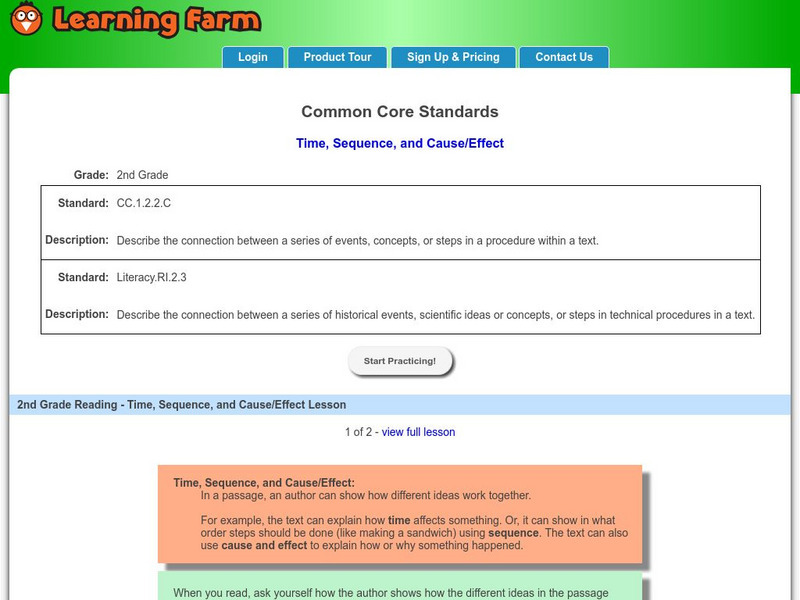Hi, what do you want to do?
Curated OER
GeoSleuth Schoolyard
Students discover that geology is something that is all around them. In groups, they participate in an activity in which they collect evidence and make observations. They solve a "murder mystery" in examining the history of a landscape.
Curriculum Corner
“I Can” Common Core! 3rd Grade Reading
Third grade readers are given clear learning goals with this Common Core checklist. By turning each reading standard into an I can statement, children can focus on mastering the required grade level skills.
Curated OER
Reading the Coyote School News: Lives of Ranchers in Southern Arizona
Fourth graders examine the effects of Mexican-American ranching on life today.
Curated OER
Checking Sources For Accuracy
Middle schoolers will paraphrase a resource without plagiarizing. Then rewrite after reading text. They then evaluate the site or reference they are using for accuracy. In the end, they complete a note-taking organizer.
Curated OER
Early Exploration of North America
Third graders "travel" from Europe to North America as Columbus did. They organize the information into chronoglogical order.
Curated OER
Narrative Literature Response Letters
Third graders write endings to a story that has already been written. They offer alternative endings in their version. The lesson includes a rubric that is to be given to the students in order that they know the requirements.
Curated OER
Language Arts: Plotting Stories
Second graders read the story, "The Foolish, Timid Rabbit," as part of a unit on appearances. After reading with partners, they write their own stories that include elements about some forms of matter from their science studies. Students...
Curated OER
Huck Finn Chapter Questions
Pupils answer chapter questions to evaluate the novel, The Adventures of Huckleberry Finn.
Curated OER
Persuade Me
Seventh graders give persuasive presentations based on the questions they have researched. They examine appropriate delivery techniques for effective persuasive presentations. (Note: This lesson should be taught, after students have...
Curated OER
Scavenger Hunt
Students search for items in various parts of the newspaper noting the different types of information it provides.
Curated OER
Number Writing Poems
Students read the short poem for each number to help them with number formation. In this numbers lesson plan, students follow directions of the poems.
Curated OER
The Experience of Diary Writing
Students read sections of Mackenzie King's diary. King was the Prime Minister of Canada during WWII. They relate the importance of keeping a diary.
Curated OER
Character Education-Perseverance
Students learn what it means to stick to a task through the re-telling of the story, "The Little Engine That Could." Personal application is made to their own experiences with the completion of, "I think I can..." endings.
Curated OER
Persuasive Speech
Tenth graders participate in a lesson that is focused on the concept of writing persuasive speechs. They conduct research from a variety of sources in order to gather information to write well informed speeches.
Curated OER
Stories of Our Lives!
Young scholars write their own books based on a life experience that they have had. In this life experiences lesson plan, students practice the writing process along with illustrating their book.
Curated OER
History of the English Language - Who Were the Anglo Saxons?
Students explore the Anglo Saxon world view, preparing them to fully explain Anglo Saxon literature.
Pennsylvania Department of Education
Giving Things a Name
Students label images seen on an interactive website. In this early writing lesson, students do their best to write the name of the object seen on the screen.
Curated OER
"What Do You Mean?" How Language Changes Over Time
Students examine words used at Jamestown in 1607. They predict what the words meant in 1607, write sentences using three of them, then analyze the sentences after they have read the actual definitions of the words.
Curated OER
Merry Easter
Fourth graders create greeting cards to special persons for a special holiday.
Curated OER
Introducing the Incredible RBT-2000
Fourth graders construct a miniature robot using recyclable materials. They write a descriptive explanation from the robot's point of view explaining how it aid in protecting the environment.
Curated OER
From Polliwog to Frog
Students examine how frogs change. In this life cycle activity, students create a model to show how a frog changes throughout its life. Students will show the process of frog metamorphosis, from polliwog to adult frog.
Learning Farm
Learning Farm: Ccs: Time, Sequence, and Cause/effect
An automated lesson will engage student's learning how to describe the connection between a series of historical events, scientific ideas or concepts, or steps in technical procedures in a text. An introduction to the concept precedes a...
ReadWriteThink
Read Write Think: Sequence of Events Chart
A printable graphic organizer to help students sequence events and recognize cause and effect relationships within a story. Directions on how to use this graphic organizer as well as lists of teaching ideas and related resources are also...




























